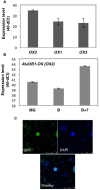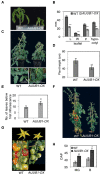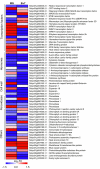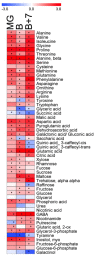Arabidopsis NAC Transcription Factor JUNGBRUNNEN1 Exerts Conserved Control Over Gibberellin and Brassinosteroid Metabolism and Signaling Genes in Tomato
- PMID: 28326087
- PMCID: PMC5339236
- DOI: 10.3389/fpls.2017.00214
Arabidopsis NAC Transcription Factor JUNGBRUNNEN1 Exerts Conserved Control Over Gibberellin and Brassinosteroid Metabolism and Signaling Genes in Tomato
Abstract
The Arabidopsis thaliana NAC transcription factor JUNGBRUNNEN1 (AtJUB1) regulates growth by directly repressing GA3ox1 and DWF4, two key genes involved in gibberellin (GA) and brassinosteroid (BR) biosynthesis, respectively, leading to GA and BR deficiency phenotypes. AtJUB1 also reduces the expression of PIF4, a bHLH transcription factor that positively controls cell elongation, while it stimulates the expression of DELLA genes, which are important repressors of growth. Here, we extend our previous findings by demonstrating that AtJUB1 induces similar GA and BR deficiency phenotypes and changes in gene expression when overexpressed in tomato (Solanum lycopersicum). Importantly, and in accordance with the growth phenotypes observed, AtJUB1 inhibits the expression of growth-supporting genes, namely the tomato orthologs of GA3ox1, DWF4 and PIF4, but activates the expression of DELLA orthologs, by directly binding to their promoters. Overexpression of AtJUB1 in tomato delays fruit ripening, which is accompanied by reduced expression of several ripening-related genes, and leads to an increase in the levels of various amino acids (mostly proline, β-alanine, and phenylalanine), γ-aminobutyric acid (GABA), and major organic acids including glutamic acid and aspartic acid. The fact that AtJUB1 exerts an inhibitory effect on the GA/BR biosynthesis and PIF4 genes but acts as a direct activator of DELLA genes in both, Arabidopsis and tomato, strongly supports the model that the molecular constituents of the JUNGBRUNNEN1 growth control module are considerably conserved across species.
Keywords: Arabidopsis; DELLA proteins; brassinosteroid; fruit; gibberellic acid; growth; tomato; transcription factor.
Figures





Similar articles
-
NAC transcription factor JUNGBRUNNEN1 enhances drought tolerance in tomato.Plant Biotechnol J. 2018 Feb;16(2):354-366. doi: 10.1111/pbi.12776. Epub 2017 Aug 4. Plant Biotechnol J. 2018. PMID: 28640975 Free PMC article.
-
Arabidopsis NAC transcription factor JUB1 regulates GA/BR metabolism and signalling.Nat Plants. 2016 Feb 29;2:16013. doi: 10.1038/nplants.2016.13. Nat Plants. 2016. PMID: 27249348
-
SlCESTA Is a Brassinosteroid-Regulated bHLH Transcription Factor of Tomato That Promotes Chilling Tolerance and Fruit Growth When Over-Expressed.Front Plant Sci. 2022 Jul 14;13:930805. doi: 10.3389/fpls.2022.930805. eCollection 2022. Front Plant Sci. 2022. PMID: 35909777 Free PMC article.
-
The ERF11 Transcription Factor Promotes Internode Elongation by Activating Gibberellin Biosynthesis and Signaling.Plant Physiol. 2016 Aug;171(4):2760-70. doi: 10.1104/pp.16.00154. Epub 2016 Jun 2. Plant Physiol. 2016. PMID: 27255484 Free PMC article.
-
Gibberellin in tomato: metabolism, signaling and role in drought responses.Mol Hortic. 2021 Nov 24;1(1):15. doi: 10.1186/s43897-021-00019-4. Mol Hortic. 2021. PMID: 37789477 Free PMC article. Review.
Cited by
-
A NAC family gene PmNAC32 associated with photoperiod promotes flower induction in Prunus mume.Hortic Res. 2025 Jun 23;12(9):uhaf157. doi: 10.1093/hr/uhaf157. eCollection 2025 Sep. Hortic Res. 2025. PMID: 40756635 Free PMC article.
-
JUNGBRUNNEN1 Confers Drought Tolerance Downstream of the HD-Zip I Transcription Factor AtHB13.Front Plant Sci. 2017 Dec 15;8:2118. doi: 10.3389/fpls.2017.02118. eCollection 2017. Front Plant Sci. 2017. PMID: 29326734 Free PMC article.
-
SlNAC12, a novel NAC-type transcription factor, confers salt stress tolerance in tomato.Plant Cell Rep. 2024 Dec 14;44(1):5. doi: 10.1007/s00299-024-03400-x. Plant Cell Rep. 2024. PMID: 39674815
-
Overexpression of a Novel Apple NAC Transcription Factor Gene, MdNAC1, Confers the Dwarf Phenotype in Transgenic Apple (Malus domestica).Genes (Basel). 2018 Apr 27;9(5):229. doi: 10.3390/genes9050229. Genes (Basel). 2018. PMID: 29702625 Free PMC article.
-
Roles of potential plant hormones and transcription factors in controlling leaf senescence and drought tolerance.Protoplasma. 2019 Mar;256(2):313-329. doi: 10.1007/s00709-018-1310-5. Epub 2018 Oct 11. Protoplasma. 2019. PMID: 30311054 Review.
References
-
- Alexander L., Grierson D. (2002). Ethylene biosynthesis and action in tomato: a model for climacteric fruit ripening. J. Exp. Bot. 53 2039–2055. - PubMed
LinkOut - more resources
Full Text Sources
Other Literature Sources
Molecular Biology Databases

